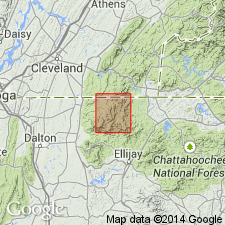
- Usage in publication:
-
- Panther Bluff Formation*
- Modifications:
-
- Named
- Dominant lithology:
-
- Sandstone
- Graywacke
- Metasandstone
- Metagraywacke
- AAPG geologic province:
-
- Piedmont-Blue Ridge province
- Appalachian basin
Summary:
The Panther Bluff Formation is here named as the lower unit of the Great Smoky Group in the Cohutta Wilderness and Hemp Top Roadless Area, GA and TN. It consists of quartzose, feldspathic, and micaceous metasandstone and metawacke with minor metashale and metaconglomerate. The Panther Bluff is in fault contact with the underlying Snowbird Group rocks and conformably underlies the lower part of the Boyd Gap Formation of the Great Smoky Group. Maximum thickness is 2,000 ft. Age is Late Proterozoic.
Source: GNU records (USGS DDS-6; Reston GNULEX).
For more information, please contact Nancy Stamm, Geologic Names Committee Secretary.
Asterisk (*) indicates published by U.S. Geological Survey authors.
"No current usage" (†) implies that a name has been abandoned or has fallen into disuse. Former usage and, if known, replacement name given in parentheses ( ).
Slash (/) indicates name conflicts with nomenclatural guidelines (CSN, 1933; ACSN, 1961, 1970; NACSN, 1983, 2005, 2021). May be explained within brackets ([ ]).

